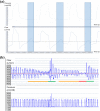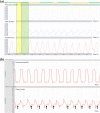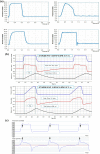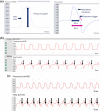Setting up home noninvasive ventilation
- PMID: 31177830
- PMCID: PMC6558539
- DOI: 10.1177/1479973119844090
Setting up home noninvasive ventilation
Abstract
Home noninvasive ventilation (NIV) is widely used to correct nocturnal alveolar hypoventilation in patients with chronic respiratory failure of various etiologies. The most commonly used ventilation mode is pressure support with a backup respiratory rate. This mode requires six main settings, as well as some additional settings that should be adjusted according to the individual patient. This review details the effect of each setting, how the settings should be adjusted according to each patient, and the risks if they are not adjusted correctly. The examples described here are based on real patient cases and bench simulations. Optimizing the settings for home NIV may improve the quality and tolerance of the treatment.
Keywords: Home noninvasive ventilation; waveform analysis.
Conflict of interest statement
Figures













References
-
- Brochard L. Intrinsic (or auto-) positive end-expiratory pressure during spontaneous or assisted ventilation. Intensive Care Med 2002; 28(11): 1552–1554. - PubMed
-
- Contal O, Adler D, Borel JC, et al. Impact of different backup respiratory rates on the efficacy of noninvasive positive pressure ventilation in obesity hypoventilation syndrome: a randomized trial. Chest 2013; 143(1): 37–46. - PubMed
-
- Vignaux L, Vargas F, Roeseler J, et al. Patient-ventilator asynchrony during non-invasive ventilation for acute respiratory failure: a multicenter study. Intensive Care Med 2009; 35(5): 840–846. - PubMed
-
- Bonmarchand G, Chevron V, Ménard JF, et al. Effects of pressure ramp slope values on the work of breathing during pressure support ventilation in restrictive patients. Crit Care Med 1999; 27(4): 715–722. - PubMed
Publication types
MeSH terms
LinkOut - more resources
Full Text Sources
Medical

